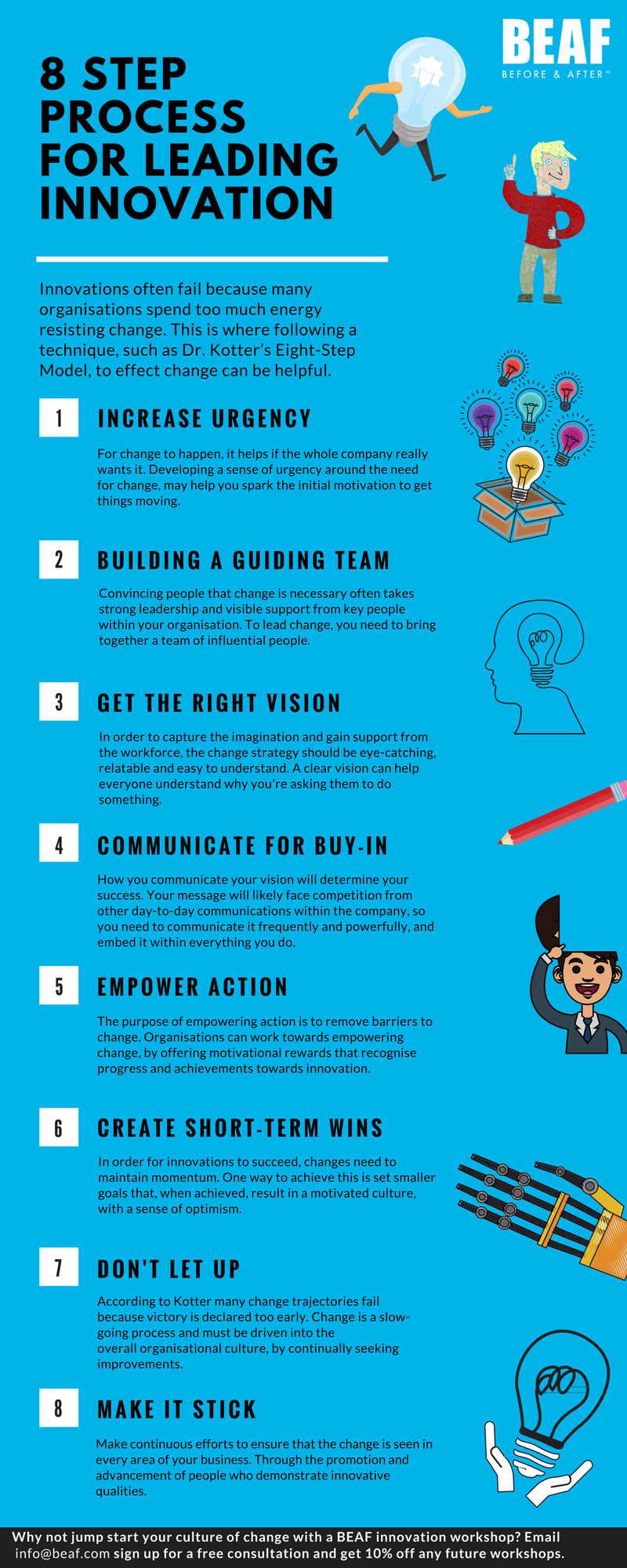We run a lot of innovation workshops, with a degree of success (even if we do say so ourselves).
However, one thing we have noticed is that there is a significant proportion of companies who come away fizzing with excitement and brimming with ideas and then … nothing. They sit on the ideas, time goes by and, ultimately, that’s that. Not only a waste of their time and money, but a real waste of potential.
Just last week, we met for the second time with a company who were interested in doing some work around a new product they were developing. We had a meeting with them about a year ago, followed up with a proposal and then… they completely disappeared. A couple of weeks ago, they got back in contact and are now keen to crack on with the project. So what happened in the interim? Well, one of their competitors released the exact product that they were thinking of developing and got a head start.
And, we have countless other examples of this happening.
So why the inertia? People may argue that it’s fear of failure that stops innovation, but we argue it is actually fear of change.
Our brains process our reaction to change through a process known as FIRE (Facts, Interpretations, Reactions, and Ends). This process uses our past experiences and personality traits, to interpret a fact and give it context and meaning. How you view your past experiences, combined with your personality determines your reaction to change.
Some people, around 38% of us, feel excited by change, resulting in more positive outcomes. Conversely, a larger proportion, around 62% are resistant to and dislike change.
In business, this can result in a broader culture of fear towards change and a reluctance to take risks. This can be particularly true in successful businesses where a ‘if it ain’t broke, don’t fix it’ attitude prevails. However, as our example shows, standing still is often a greater risk to success than change.
You only have to look at failed businesses like Blockbuster to see that, with inertia, comes the risk of failure.
Another reason why we fear change is because it challenges the status quo. Over time we create systems and processes we know to work efficiently. Habits are formed and it becomes hard to see things in a new way.
So how can we overcome these barriers to create an environment where innovation can thrive? This article will make a few suggestions:
Create a Climate for Change
Innovations often fail because many organisations spend too much energy resisting change. This is where following a technique, such as Dr. Kotter’s Eight-Step Model, can be helpful.
Kotter’s model was a result of a Harvard Business School study that explored the failure rate of business change. The study found that most efforts to change fail “because organisations often do not take the holistic approach required to see the change through”.
Using their findings, Dr Kotter then created an eight-step process for leading change, which we will explain in more detail here.

Step 1
Increase Urgency
Gaining momentum for change is often the key to innovation.
Managers and innovation leaders can foster a culture of innovation by having open conversations about where the organisation lies within the marketplace. The purpose of which, is to provide compelling reasons why change is vital to continued success and to highlight the risks of standing still.
Step 2
Building the Guiding Team
Once an organisation is unified on the need for change, it is then vital that organisations put the right innovation leaders in place. The right leaders should not only possess the required knowledge and skills, but also be emotionally committed to change.
The next step is to put together a team to handle the change process. It is a good idea to have a mix of people who can bring different skills and knowledge to the process. Having the right mix of skills and competencies within the guiding group is necessary to give the change process credibility.
When BEAF runs innovation workshops, we always ensure the group consists of different types of workers within the company. This ensures a wider variety of viewpoints, experiences and opinions, rather than just the single, top-down view that a management-only team typically brings.
The people within the guiding team need to have the correct leadership skills, level of authority and knowledge required to successfully convince the organisation to embrace change.
Step 3
Get the Right Vision
The guiding team must then work together to create a vision, with a clear direction and strategy for change.
Simply telling people what the changes will be is unlikely to galvanise support for innovation. In order to capture the imagination of and gain support from the workforce, the vision and strategy need to be eye-catching, relatable and easy to understand.
Step 4
Communicate for Buy-in
Innovation processes often create a lot of information and it’s important that we’re careful not to overburden individuals with this.
Instead, a better approach is to communicate key information in a captivating way. It is vital that any anxieties or concerns are listened to and that the lines of communication are always open.
Step 5
Empower Action
The purpose of empowering action is to remove barriers to change. Organisations can work towards empowering change by offering motivational rewards that recognise progress and achievements towards innovation. The idea is to create an environment where embracing change and leading innovation is actively encouraged.
In one £35m turnover business we’re currently developing a new product for, the idea came from one of their factory workers. He approached the CEO with it, and was able to drive it forward – this wouldn’t have happened in a company that doesn’t actively search for, and embrace, innovation.
Step 6
Create Short-Term Wins
In order for innovation to succeed, changes need to maintain momentum. One way to achieve this is set smaller goals that, when achieved, result in a motivated culture, with a sense of optimism.
Furthermore, creating short-term wins help to validate strategies, whilst also providing opportunities for recognition and quieting the voice of cynics.
Step 7
Don’t Let Up
Step 7 is about maintaining momentum over the longer term and building on earlier changes. It’s about maintaining a culture that embraces change through determination and persistence.
Ongoing progress reporting can be useful throughout this stage, by highlighting achieved milestones and keeping a focus on future plans and projections.
Step 8
Make it Stick
This step is about reinforcing a change culture through recruitment and promotion. It’s about communicating the value of being receptive to change through the promotion and advancement of people who demonstrate adaptability and innovative qualities.
Why not jump start your culture of change with a BEAF innovation workshop? Click here to sign up for a free consultation and get 10% off any future workshops.


